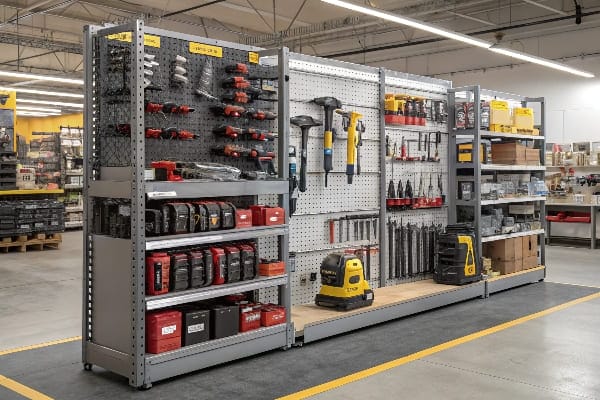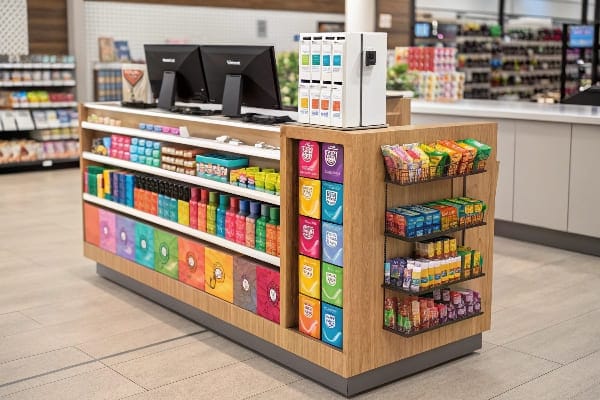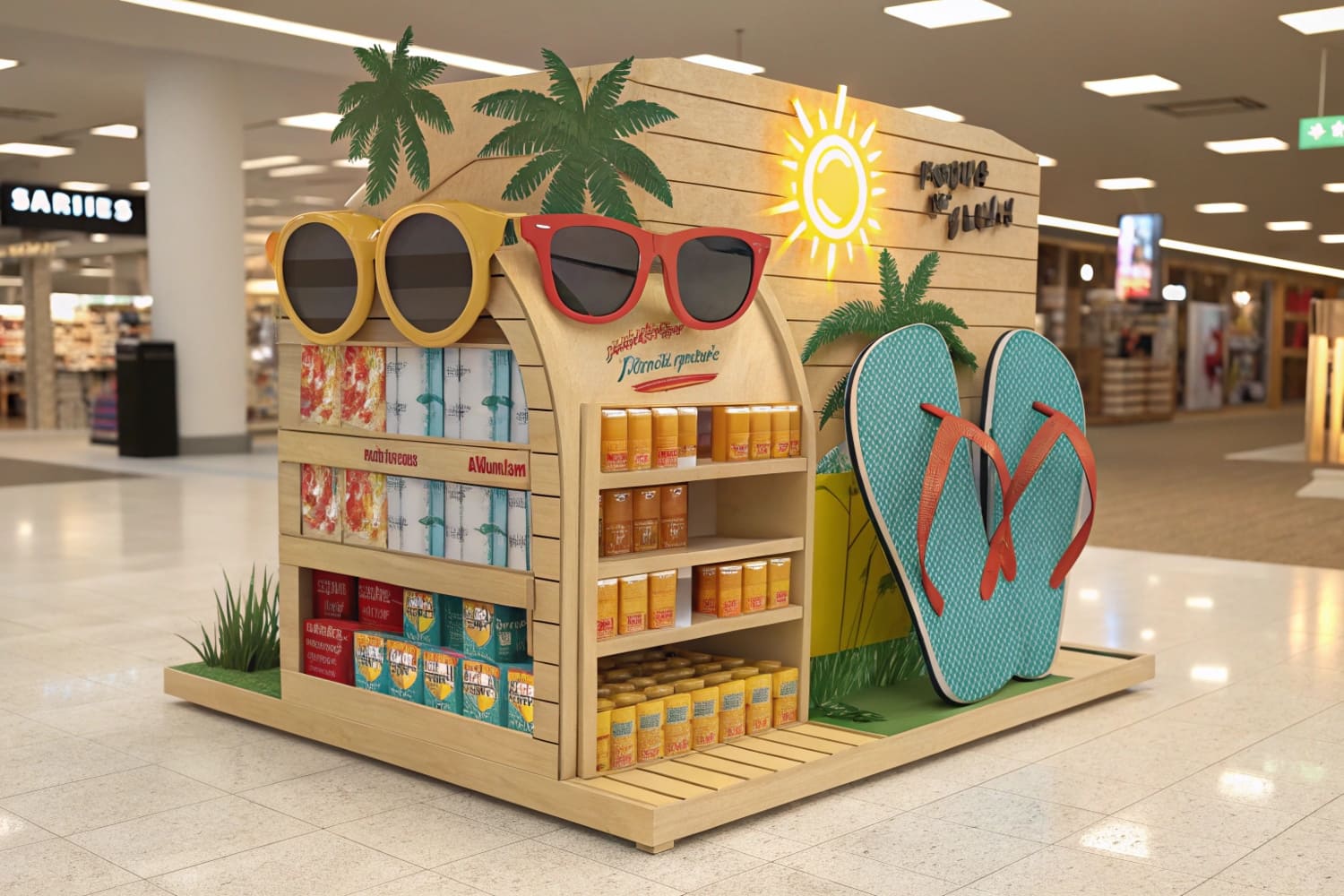Les présentoirs en magasin échouent pour des raisons simples : un espace mal agencé, une structure fragile et un design plat. J’y remédie grâce à des méthodes de travail sécurisées, une conception robuste en carton et des tests créatifs rapides.
Utilisez une mise en place par étapes, choisissez des structures en carton ondulé testées, approuvez les épreuves couleur, concevez pour le flux de circulation, documentez les réinitialisations, actualisez à une cadence définie, suivez les ventes et associez-vous à un fabricant de présentoirs en carton fiable.

Je travaille avec des marques dynamiques qui ne peuvent se permettre la moindre erreur. Je privilégie la simplicité. Je détaille les étapes. Je m'appuie sur les données de terrain. J'utilise des matériaux sûrs. Je teste la charge dès le début.
Comment protéger une zone d'affichage pendant le processus de merchandising?
L'environnement de vente au détail évolue rapidement. Les gens circulent, les palettes bougent et le temps est compté. Je constate que la plupart des accidents et des dommages aux produits surviennent lors de la mise en place, et non après. C'est pourquoi je considère la mise en place comme une étape de la production, et non comme une tâche secondaire.
Assurez la sécurité des personnes et des stocks en délimitant la zone, en utilisant des EPI, en sécurisant les charges, en verrouillant les roues, en signalant les points de trébuchement, en suivant une procédure opérationnelle standard de montage étape par étape et en inspectant chaque étagère et chaque fixation avant le stockage.

La sécurité d'abord, puis la vitesse.
Je planifie le montage comme un mini-projet. Je parcours le trajet de l'arrière-boutique jusqu'au site. Je délimite une zone tampon (zone 1) avec des cônes et du ruban adhésif au sol. J'installe un panneau simple indiquant « Montage en cours ». Je désigne une personne pour surveiller la circulation des chariots élévateurs. Je vérifie la nomenclature et la charge admissible. Je porte des gants pour plier les pièces ondulées lourdes. J'affûte les lames pour réduire la force et éviter les glissements. Je monte de la base vers le haut. Je n'ajoute de produit qu'après un test de stabilité rapide (test de secouage ) . Je corrige tout jeu avec des entretoises invisibles ou des pieds plus larges. Je consigne le montage par une brève note et une photo. Cela paraît simple, mais ça fonctionne à tous les coups.
Risques et contrôles typiques
| Risque | À quoi ça ressemble | Contrôle simple |
|---|---|---|
| Dangers de voyage3 | Sangles lâches, extrémités en film rétractable | Coupez et jetez tous les emballages ; scotchez les bords |
| Écraser ou pourboire | Tours hautes et étroites | Ajouter du lest, une base plus large, contre un embout |
| Blessures à la lame4 | Ouverture précipitée | Utilisez des couteaux de sécurité ; changez les lames. |
| Surcharge | Étagères bombées | Respectez les cartes de chargement ; répartissez le poids |
| Flux des clients | Pincement d'allée | Conservez un dégagement de 91 cm (36 pouces) ; inclinez la tête d'encastrement. |
J'utilise des panneaux ondulés avec des étiquettes de chargement transparentes. Je privilégie les panneaux simple cannelure 5 pour la rapidité et les panneaux double cannelure 6 . Je préfère les kits en kit pour dégager les allées. Je fais une dernière vérification de 60 secondes avant de retirer les cônes. La sécurité est désormais intégrée, et non plus ajoutée a posteriori.
Comment puis-je améliorer mon affichage de magasin?
La plupart des présentoirs échouent car ils obligent les clients à chercher. Si le client doit deviner, la vente chute. Je conçois mes présentoirs de manière à ce que le client connaisse le produit, son prix et l'étape suivante en deux secondes.
Améliorez l'impact en clarifiant l'histoire d'un seul produit, en simplifiant le texte, en plaçant le SKU principal à hauteur de main, en utilisant des étiquettes de prix à contraste élevé, en ajoutant un QR code pour les spécifications et en testant deux versions pendant une semaine chacune.

Que faut-il corriger en premier, et comment le tester ?
Je commence par optimiser la visibilité. Je place le produit phare (référence 7) entre 107 et 137 cm. J'utilise un slogan percutant de sept mots maximum. Je limite la couleur à deux couleurs de la marque, plus le blanc. J'utilise une police lisible pour les prix. J'ajoute un QR code ou une puce NFC pour les caractéristiques techniques afin de préserver la propreté de l'emballage. J'incline les étagères de cinq degrés pour une meilleure visibilité. J'imprime sur du carton recyclable (référence 8) avec des encres à base d'eau. Je teste deux versions pendant une semaine chacune dans des magasins à fréquentation similaire. Je suis le taux de retrait en magasin, le taux de conversion et les stocks disponibles.
| Élément | Action | Pourquoi cela aide | Métrique rapide |
|---|---|---|---|
| Tête9 | Une ligne de prestations | Arrête le défilement des yeux | Temps de séjour + |
| Angle de l'étagère | Inclinaison de 5° | Améliore la lecture des paquets | Taux de prise en charge + |
| Étiquette de prix10 | Contraste élevé | Réduit la confusion | Vérifications de prix – |
| QR/NFC | Caractéristiques techniques et vidéo | Répond rapidement aux doutes | Vitesse de numérisation + |
| Couleur | Deux couleurs + blanc | Réduit le bruit | Taux de rebond – |
J'ai collaboré avec une marque d'articles de chasse qui vendait des arbalètes. L'équipe utilisait un présentoir métallique lourd. Il paraissait robuste, mais la lecture était lente. Nous sommes passés à un présentoir sur palette à double paroi (11) avec un message de sécurité (12) , un prix clairement affiché et un lien rapide vers une démonstration de 30 secondes. Pour plus de sécurité, nous avons verrouillé les flèches près de la poignée. Nous avons surélevé l'arbalète vedette à hauteur de main. Les ventes ont augmenté de 28 % en deux semaines. L'équipe a conservé le même encombrement et a réduit ses frais de transport, car le kit était expédié à plat.
Pourquoi les écrans devraient-ils être modifiés régulièrement?
Les clients ne voient plus que des choses figées. Le personnel change. Les saisons se succèdent. De nouveaux concurrents font leur apparition. Une présentation qui cartonne aujourd'hui sera démodée le mois prochain. Je planifie les changements avant même l'expédition du premier produit.
Renouvelez régulièrement les présentoirs pour lutter contre la lassitude des consommateurs, les adapter aux saisons, les aligner sur les lancements de produits, garantir un niveau élevé de conformité et renouveler constamment les supports ; de petites mises à jour mensuelles sont préférables à de rares refontes majeures.

La cadence l'emporte sur le chaos
J'utilise un calendrier simple. Je prévois un changement d'en-tête chaque mois. Je fais tourner les références phares chaque trimestre. Je procède à une refonte complète deux fois par an. Ce rythme régulier permet de renouveler constamment l'image de marque et de maintenir la sérénité au sein de l'équipe. Les présentoirs en carton facilitent cette tâche, car les en-têtes et les plateaux se changent rapidement. L'impression numérique me permet de produire de petites séries avec une grande précision des couleurs. PLV de sol représentent une part importante du marché, car leur impact est direct et un renouvellement rapide permet de le maintenir. En Amérique du Nord, cette situation est courante, car le secteur du commerce de détail y est mature. En Asie-Pacifique, la croissance est rapide ; il est donc important de renouveler régulièrement les présentoirs pour attirer les nouveaux clients qui découvrent le commerce moderne.
| Catégorie | Échange mensuel15 | Rotation trimestrielle16 | Réinitialisation semestrielle |
|---|---|---|---|
| Collations | Image d'en-tête | Héros des saveurs | Accord de structure |
| Beauté | Offre autocollant | Héros de l'ombre | Disposition du plateau |
| Matériel | Carte de prix | Appel de la référence SKU | Panneau de sécurité |
Je planifie les échanges en développement durable . Je conçois des cadres personnalisables et trie les matériaux pour un recyclage propre. J'évite les laminations plastiques sauf nécessité. J'utilise des encres à base d'eau . Je conserve un kit de réparation en réserve pour prolonger la durée de vie des cadres. Cela permet de réduire les coûts tout en préservant la fraîcheur des histoires.
Pourquoi est-il important de maintenir les écrans?
Un présentoir est un outil vivant. Il bouge, il supporte du poids et il est manipulé toute la journée. Si personne n'en assure l'entretien, les ventes diminuent et les petits problèmes s'aggravent.
Maintenir les présentoirs en bon état permet de protéger les clients, les stocks, de préserver la confiance envers la marque, de réduire les pertes, de prolonger la durée de vie des présentoirs et de maintenir les ventes ; une vérification quotidienne de cinq minutes évite les réaménagements coûteux et les incidents de sécurité.

Rendez l'entretien facile, visible et régulier
Dès le premier jour, j'attribue les responsabilités. Je fournis à l'équipe une liste de contrôle (19) . Je dispense une formation à l'aide d'une vidéo de démonstration de deux minutes. Je place une petite pochette de réparation (20) derrière l'unité, contenant du ruban adhésif, des crochets supplémentaires, des étiquettes d'étagère et une lingette alcoolisée pour les éraflures. Je conserve une fiche de chargement imprimée sur le panneau intérieur. J'établis une règle simple : si une étagère est bombée, retirez cinq unités et rééquilibrez-les. Si un bandeau se décolle, remplacez-le immédiatement. Je consigne chaque réparation avec la date et mes initiales. Cette petite habitude favorise la fierté et évite les gros travaux.
| Fréquence | Tâche | Outil | Règle de réussite/échec |
|---|---|---|---|
| Quotidiennement (5 min) | Appliquer le produit sur le visage, enlever les déchets, essuyer les éraflures | Essuyer, poubelle | Tous les revêtements étaient remplis |
| Hebdomadaire (10 min) | Resserrer les clips, vérifier le jeu, remplacer les étiquettes | Ensemble de clips, ruban adhésif | Aucune oscillation après la secousse |
| Mensuel (15 min) | Inverser l'en-tête, vérifier la décoloration des couleurs 21 , examiner les numérisations | Nouvel en-tête, graphique | Vitesse de balayage stable ou en hausse |
| Trimestriel (30 min) | Inspecter le chargement, recycler, commander à nouveau les pièces de rechange | Carte de chargement, vidéo | Aucune déformation de l'étagère à pleine charge |
Je privilégie le carton ondulé avec impression nano-revêtue 22 pour les zones humides, car il résiste aux éclaboussures et aux UV tout en étant recyclable. J'utilise du carton simple cannelure pour les produits légers et du carton double cannelure pour les kits lourds. Je teste la résistance en atelier avec un test de charge statique rapide et un test de vibration simple. Je rédige également un court plan d'action « En cas de casse, alors ». Si le fond est écrasé, je retire le stock, je déballe les pièces à plat et je demande un remplacement. Si une pièce est manquante, j'utilise la pièce de rechange fournie et j'envoie la référence par e-mail pour la commander à nouveau. Ce plan clair garantit une disponibilité maximale et préserve l'image de marque.
Conclusion
Planifiez des développements sécurisés, améliorez la clarté, actualisez régulièrement vos connaissances et maintenez-les grâce à des routines courtes. Ces quatre habitudes permettent d'éviter les erreurs coûteuses et d'augmenter les ventes sans stress ni gaspillage.
La compréhension des zones tampons est essentielle pour garantir la sécurité sur les chantiers, contribuant ainsi à prévenir les accidents et les blessures. ↩
Se renseigner sur les tests de secousses permet d'améliorer ses connaissances en matière d'intégrité structurelle, garantissant ainsi des constructions plus sûres et plus fiables. ↩
Explorez ce lien pour découvrir des stratégies efficaces d'identification et de réduction des risques de trébuchement, et ainsi garantir un environnement plus sûr. ↩
Découvrez les mesures et outils de sécurité essentiels pour prévenir les blessures par lame, améliorer la sécurité au travail et le bien-être des employés. ↩
Explorez ce lien pour comprendre comment le carton simple cannelure peut améliorer la rapidité et l'efficacité de votre processus d'emballage. ↩
Cette ressource expliquera les avantages de l'emballage à double paroi pour le transport sécurisé d'objets lourds. ↩
Comprendre le concept de référence produit phare peut vous aider à optimiser le placement de vos produits et à augmenter vos ventes. ↩
Explorer les avantages du carton recyclable peut renforcer vos efforts en matière de développement durable et séduire les consommateurs soucieux de l'environnement. ↩
Découvrez comment des titres efficaces peuvent capter l'attention et améliorer l'engagement dans votre stratégie marketing. ↩
Découvrez l'impact du design des étiquettes de prix sur la prise de décision des clients et les performances commerciales. ↩
Explorez ce lien pour comprendre comment les présentoirs à palettes à double paroi peuvent améliorer la visibilité des produits et les ventes. ↩
Découvrez des informations sur l'importance des allégations de sécurité en marketing et sur la manière dont elles peuvent influencer le comportement des acheteurs. ↩
Découvrez comment les présentoirs en carton peuvent optimiser votre stratégie de vente au détail et améliorer l'engagement client. ↩
Découvrez l'efficacité des présentoirs de sol pour stimuler les ventes et attirer les clients en magasin. ↩
Comprendre les échanges mensuels peut améliorer votre stratégie produit et maintenir l'intérêt de vos offres. ↩
Explorer la rotation trimestrielle peut vous aider à optimiser vos stocks et à améliorer vos performances de vente. ↩
L’exploration de cette ressource vous permettra de mieux comprendre les pratiques de conception durable qui peuvent améliorer vos projets. ↩
Découvrez les avantages des encres à base d'eau, qui peuvent améliorer vos efforts de conception écologique. ↩
Découvrez comment les listes de contrôle peuvent rationaliser les processus et garantir la responsabilisation, rendant ainsi la maintenance plus facile et plus efficace. ↩
Explorez ce lien pour comprendre les avantages d'une pochette de réparation en matière de maintenance, d'amélioration de l'efficacité et d'organisation. ↩
Se renseigner sur les audits de décoloration peut contribuer à préserver l'attrait des produits et à garantir une image de marque cohérente. ↩
Explorez les avantages des impressions nano-revêtues, notamment dans les zones humides, pour améliorer la durabilité et la pérennité de vos solutions d'emballage. ↩





